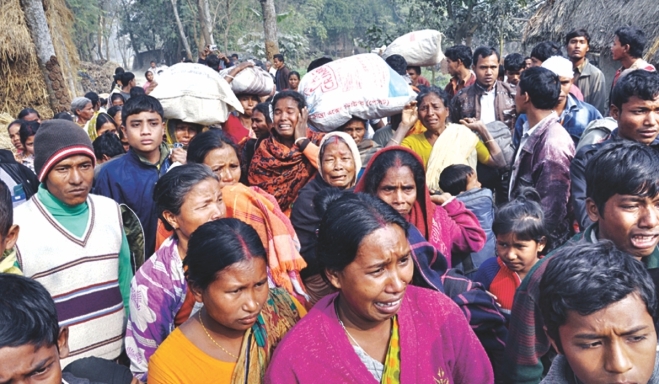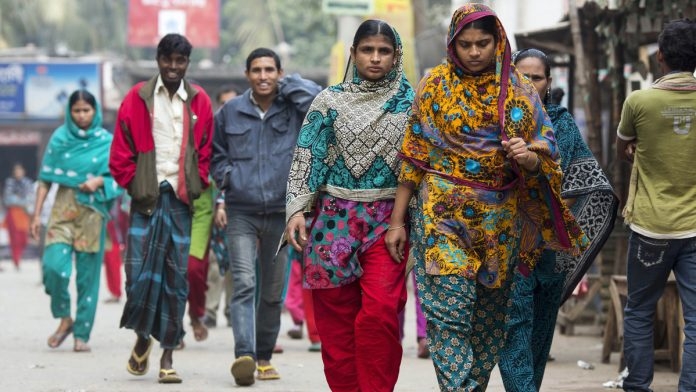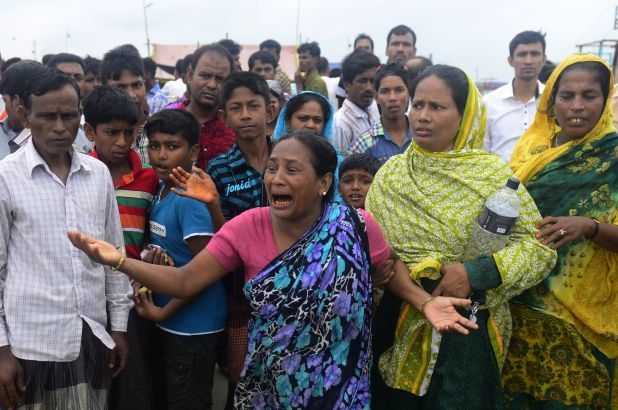The Expatriation of Minorities from Bangladesh: Facts and Future
Abstract: A History of bloodshed against minority prevailed even before independence from British and the violence against minority was a common phenomenon till today’s Bangladesh. Since 1947 the violence against minority in Pakistan and Bangladesh followed irrespective of political parties. The innumerable incidence of atrocities against minorities like killing, rape, slaughter, forcible annexation of properties, burning of houses and abduction are taking place and in considerable number of cases the violators are the cadres of various political parties irrespective to ruling or are in opposition. According to an estimation, 675 people belonging to the minority community are migrating from Bangladesh daily (Prof. Dr Abul Barkat, Chairman HDRC). The minorities’ populations are declining over a period of time. In this study, it prevailed the root cause of declining the community as well as tortured atrocity and unfold pain of minorities of Bangladesh.

Introduction: Bangladesh born in 1971, premised on a secular and democratic ethos as paragraph- 2 of the preamble of the first constitution of Bangladesh which was adopted on November 4, 1972 accepted nationalism, socialism, democracy and secularism as state principles. But soon after its birth the political history and politics of Bangladesh found itself within the twists and turn of different politics. Eighth Amendment to the constitution on June 1988, Islam was declared as the state religion of Bangladesh with the provision that other religions may be practiced in peace and harmony. The above changes were brought about by successive political regime to consolidate their power. However, this is not only transformed the political identity of the state but also created internal polarization (mohsin 2009). Since then the minority community face discrimination and continuous atrocities and violence as reported by many scholars of world bodies. It is also documented that the political process and the political parties were a major source of discrimination against minorities.
Background of the study:
According to the 2001 census, the size of Hindu Minority population was 11.6 million which means since the past 27 years, 1.7 million population was added yielding 0.6% annual average growth rate. By contrast, other population almost doubled from 61 million to 111 million and the annual growth rate was 2.2% during the same period. Therefore, the share of minority Hindu population to the country’s decline from 13.5% to 9.2% during the same period and by 1.79% since 1991, whilst the relative composition of Christian and Buddhist population did not change. Further, the Minority Hindu population declined to 8.2% in the country with annual growth rate coming down to 0.05%between 2001 to 2011 and it is projected that in 2051 the share of minority population will decline to 3.7%.
| Census Year | Total % | Muslim % | Minorities % |
| 1941 | 100 | 70.30 | 29.70 |
| 1951 | 100 | 76.90 | 23.10 |
| 1961 | 100 | 80.40 | 19.60 |
| 1974 | 100 | 85.40 | 14.60 |
| 1981 | 100 | 86.70 | 13.30 |
| 1991 | 100 | 88.30 | 11.70 |
| 2001 | 100 | 89.70 | 10.30 |
| 2011 | 100 | 90.34% | 9.64 |
May 2013, Statistical and Informatics Division (SID), Ministry of planning
An Article in Time magazine dated 2 august 1971, stated ‘The Minority Hindu, who account for three- fourths of the refugees and a majority of the dead, have borne the brunt of the Pakistani military hatred (wiki 2014). According to BBC (9 march 2013)’ official estimates say more than million killed and tens thousands of women raped during the war of independence. The minority community suffered disproportionately because some Pakistanis blamed them for Bangladesh’s secession. The minority leaders say the attacks are systematic and have been going on for years till today. The aims of the violence, the few scholars allege, is to grab land and other property. As a result the minority Hindus are fleeing to India to escape harassment, intimidation and violence (BBC. 9 march 2013.
Many Scholars like Salam Azad (Executive Director, Amity for peace, Bangladesh) hold the view that Islam became state religion in Bangladesh, a concept diametrically opposed to the slogans and principles on the basis of which the Bangladesh freedom movement started i.e. secularism and democracy. Consequently, the minorities have been marginalized to the extent that they became unwanted low grade citizens in their in their own country.

“We left our house in 1971 as the Pakistani army and Razakars set fire to our village and we are at the same ordeal in the recent year” said Biswajit sarkar of Molopara in Abhaynagar, Jessore (The Daily star Jauary 2, 2014). Soon after the voting ended in Bangladesh, the minorities had to face the ire of the activist of terrorist group irrespective to political parties. Minorities’ houses have been looted vandalized and burned in several places like Thakurgaon, Rangpur, Bogra, Lalmonirhat, Rajshahi, Chittagong and Jessore (The Daily star, January 7, 2014). According to the New age ‘ Miscreants attacked minorities localities, temples and business establishments in Jessore, Satkhira, Panchagarh, Chittagong, Nilphamari, Kurigram, Lalmonirhat, Gaibandha, Dinajpur, Netrakona and some other districts after the national elections (The New Age, January 11, 2014)
According to the reports, almost five hundred minorities’ family of Gopalpur village were affected in these classes and become homeless. Besides this, at least 350 houses and 50 shops of five villages including Pritompara, Sahapara, Telipara, Madhabpara and Ajaypara of Konai village were damaged, set ablaze and looted (The Daily star January 7, 2014). The minorities also attacked and looted at Satkania, Loahagora and Banshkhali Upazilas Kaunia upazila of Rangpur and Nandi gram Upazila in Bogra. Even homestead trees even coconut and bananas were burnt or chopped and cowsheds were burnt too. Idols in the houses were vandalized and everything else was looted. (Dhaka Tribune January 7, 2014). The larger objective of these kinds of violence and attack is to grab the land of minorities. According to Jayotrimoy Barua, a Supreme Court lawyer in Dhaka “when we say it’s just political, it legitimizes the violence. Most of the people’s houses they are burning are poor. If you burn their houses, they will leave the country, and you get their land”. The vested properties Act remained in force until 2001, allowing the government to expropriate; enemy lands. Over the course of its existence, the government seized approximately 2.6 million acres of land, affecting almost all minorities in the country (IRFR, 2012). Once land is acquired, the influential and political people used to grab those lands and most of the minorities’ families in Bangladesh are affected by this law. According to Prof Barkat et al (2008), in most of the cases, the beneficiaries of those vested properties are the influential political people of different areas across political parties. To know the causes of violence against minorities is very importance issues today.
Objectives:
a) To assess the impact of Violence on the affected persons and beneficiaries
b) To identify different categories of cases affected by the violence against minorities
c) To assess the various dimensions of the magnitude of the problem
d) To suggest specific, achievable and realistic solutions
Methodology:
Parties Both primary and secondary sources of information will used in the base- studies. The base studies involved review of all relevant available literature, assessment based on the information obtained from questionnaire sample survey, in-depth case studies and discussion with various knowledgeable persons.
The key features of the base study include conduction of in depth case studies and combination of participatory and qualitative technique. A series of group discussions involving different actors were conducted to discuss about the various dimensions of the cases, formulate possible solutions and identify possible roles each shareholders at the various stages in solving the problem. In addition to the 10 in-depth case studies with affected persons, a total 50 affected persons will be interviewed using questionnaire. The following table shows which the levels and types of person will be interviewed.
Table: Persons interviewed and discussed at various levels
| Level | Person |
| National level | Welfare ministry and Ministry of Religious affairs–Member of Parliament, political Leaders, Journalists, Minority Community leaders. |
| District level | Lawyers, journalists, teachers, Cultural Activists, NGO leaders |
| Thana level | Lawyers, Teachers, Cultural leaders, religious leaders |
| Union level/ Grass root level | School/College teachers, local leaders/chairman, Religious leaders |
| Union / Thana level | Affected persons 1. 10 in-depth case studies 2. 50 interviews with affected persons |
However, qualified and experienced researcher including me will involve collecting qualitative information and in- depth case study will be conducted to the affected people.
Literacy Review:
1. An inquiry into causes and consequences of deprivation of Hindu Minorities in Bangladesh through the vested property Act: ( Prof Dr Abul Barkat et al 2008) The book mentioned regards the vested property Act that violates all the fundamental human rights. This Act is contradictory to the Proclamation of Independence 1971, contradicts the basic premises of constitutional Provisions of equity, equality, freedom and justice for all citizens. This Act is communal, anti Human, anti democracy. The book mention regards the law but here we have to emphasize more vigorously why the people are the affected and try to find out the root cause of violence against minority.
2. National Crisis and rights of Rohingya Refugee Children: A sociological Analysis of children’s Rights in Bangladesh- It is a thesis paper that is prepared to the Department of Sociology, University of Dhaka 11th January 2014. It is also pretty much effective how the Children are affected to the minority.
3. Journal that published by some of the non-governmental organizations (NGOs) and civil society organizations sent investigation teams into the affected areas. A joint team consisted of members from Ain ‘O Shalish Kendra, Sammolito Samajik Andolon, Nijera Kori, Bangladesh Nari Progoti Shongho, Nari Uddyog, Bangladesh Mohila Parishad, Bangladesh Legal Aid and Services Trust, and the Society for Environment and Development. Several organizations of the investigation team attended a press conference held in various times 2001 to 2015. Through the press conference these organizations appealed to government, political parties and civil society members to take measures to rehabilitate persons affected by human rights violations. Their publication also very effective to complete this paper.

Conclusion:
This paper demonstrates that seeds of violence against the minority community are inherent within the processes and structures of the modern state system, which has led to the dehumanization of humans and politics. Humans have been boxed into identities that either privilege or marginalize them through discriminatory laws and principles. In the name of politics, the system of majoritarian democracy has threatened individual autonomy and turned human beings into vote banks and vote constituencies. Lack of accountability and transparency of the state machinery only makes the situation worse. In other words, the state has failed to provide human security to its minority communities. The repeal of the Vested Property Act has done little to assuage the grievances of the minority community, since the principles and ideology of the state privilege the dominant community. To escape this vortex of violence, the structures of state and society have to be democratized in the true sense of the word. The Bangladesh state must recognize the plurality of its culture and people. This paper has argued that the political elite whip up religious fanaticism for its own vested interests. This, I am positing here, is not done out of love for religion. These issues need to be brought to the fore through community movements, seminars, dialogues, workshops, and change in academic curricula to know the root cause of their diminishing nature. Undoubtedly, this research has the most important role to play to find out the cause root of untold pain. A politically and humanely conscious citizenry can provide the best safeguard for its own security by compelling the government to democratize itself and make itself to people-oriented to ensure the growth and development.
Bibliography:
1. An inquiry into causes and consequences of deprivation of Hindu Minorities in Bangladesh through the vested property Act. ( Prof Abul Barkat et. Al. 2008)
2. Mohsin.A (2009), Religion – A tool for discrimination in South Asia, Bangladesh ( 1st Chapter), Soth Asians for Human Rights( SAHR), Colombo, Srilanka.
3. Azad S., Status of minority communities of Bangladesh, 2013.
4. Ain ‘O Shalish Kendra, Bangladesh Legal Aid and Services Trust and Odhikar, Human Rights in Bangladesh, 1997 (Dhaka: University Press, 1997), 116.
5. 2. C. T. Maloney, “Tribes of Bangladesh and Synthesis of Bengali Culture,” in M. S. Qureshi, ed., Tribal Cultures in Bangladesh (Rajshahi University: Institute of Bangladesh Studies, 1984), 8.
6. Anisuzzaman, Creativity, Reality and Identity (Dhaka: International Center for Bengal Studies, 1993), 107.
7. For details, see Rounaq Jahan, Pakistan: Failure in National Integration (Dhaka: University Press, 1972).
8. Government of Bangladesh, Parliament Debates, October 12, 1972 (Dhaka: Government of Bangladesh, 1972), 20.
9. The Constitution of the People’s Republic of Bangladesh, Ministry of Law (Dhaka: Government of Bangladesh, 1972),5
10. Talukdar Maniruzzaman, “Bangladesh Politics: Secular and Islamic Trends,” in Rafiuddin Ahmed, ed., Religion, Nationalism and Politics in Bangladesh (New Delhi: South Asia Publishers, 1990), 69.
11. Abul Barkat and Shafiquzzaman, Political Economy of the Vested Property Act in Rural Bangladesh (Dhaka: Association for Land Reforms and Development, 1997), 27.
12. Meghna Guhathakurta, “Politics in South Asia and the Hindus of Bangladesh,” Lipi Ghosh and Moniruddin, eds., Minorities, Nationalities and Identity Formation in South Asia, Kolkata, 2013.
13. BBC ( March9, 2013) Bangladesh Minorities ‘ Terrorized’ After mob Violence
14. New Age ( January 11, 2014) attack minorities
15. The Daily Star (January 07, 2014) Hindus under treat.


